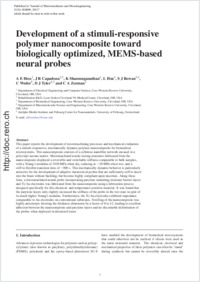Development of a stimuli-responsive polymer nanocomposite toward biologically optimized, MEMS-based neural probes
- Hess, Andreas E. Department of Electrical Engineering and Computer Science, Case Western Reserve University, Cleveland, USA
- Capadona, Jeffrey R. Rehabilitation R& D, Louis Stokes Cleveland VA Medical Center, USA - Department of Biomedical Engineering, Case Western Reserve University, Cleveland, USA
- Shanmuganathan, Kadhiravan Department of Macromolecular Science and Engineering, Case Western Reserve University, Cleveland, USA
- Hsu, L. Department of Macromolecular Science and Engineering, Case Western Reserve University, Cleveland, USA
- Rowan, Suart J. Department of Biomedical Engineering, Case Western Reserve University, Cleveland, USA - Department of Macromolecular Science and Engineering, Case Western Reserve University, Cleveland, USA
- Weder, Christoph Adolphe Merkle Institute and Fribourg Center for Nanomaterials, University of Fribourg, Switzerland
- Tyler, D. J. Rehabilitation R& D, Louis Stokes Cleveland VA Medical Center, USA - Department of Biomedical Engineering, Case Western Reserve University, Cleveland, USA
- Zorman, C. A. Department of Electrical Engineering and Computer Science, Case Western Reserve University, Cleveland, USA
-
28.04.2011
Published in:
- Journal of Micromechanics and Microengineering. - 2011, vol. 21, no. 5, p. 054009
English
This paper reports the development of micromachining processes and mechanical evaluation of a stimuli-responsive, mechanically dynamic polymer nanocomposite for biomedical microsystems. This nanocomposite consists of a cellulose nanofiber network encased in a polyvinyl acetate matrix. Micromachined tensile testing structures fabricated from the nanocomposite displayed a reversible and switchable stiffness comparable to bulk samples, with a Young's modulus of 3420 MPa when dry, reducing to ~20 MPa when wet, and a stiff-to-flexible transition time of ~300 s. This mechanically dynamic behavior is particularly attractive for the development of adaptive intracortical probes that are sufficiently stiff to insert into the brain without buckling, but become highly compliant upon insertion. Along these lines, a micromachined neural probe incorporating parylene insulating/moisture barrier layers and Ti/Au electrodes was fabricated from the nanocomposite using a fabrication process designed specifically for this chemical- and temperature-sensitive material. It was found that the parylene layers only slightly increased the stiffness of the probe in the wet state in spite of its much higher Young's modulus. Furthermore, the Ti/Au electrodes exhibited impedance comparable to Au electrodes on conventional substrates. Swelling of the nanocomposite was highly anisotropic favoring the thickness dimension by a factor of 8 to 12, leading to excellent adhesion between the nanocomposite and parylene layers and no discernable deformation of the probes when deployed in deionized water.
- Faculty
- Faculté des sciences et de médecine
- Department
- AMI - Chimie des polymères et matériaux
- Language
-
- English
- Classification
- Physics
- License
-
License undefined
- Identifiers
-
- RERO DOC 22445
- DOI 10.1088/0960-1317/21/5/054009
- Persistent URL
- https://folia.unifr.ch/unifr/documents/301850
Statistics
Document views: 128
File downloads:
- pdf: 344
